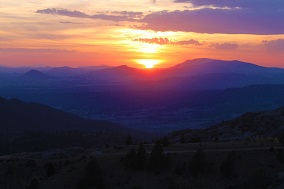Scenario
An editor opens her submissions queue and finds she’s received 600 unsolicited submissions this week. She looks at the middle school poster on her wall, it is of a unicorn with a pink main and tail and golden horn. She’s named the unicorn Unsolicited Submitter. She sighs then assigns the submissions to her readers. There are three of them. They are entry level staff volunteers whose jobs are to weed out the obvious declines and promote the maybes.
Reader #1: Bob
 Bob was just rejected by his favorite literary journal that morning after the journal kept his work for 285 days. He really wants to be head editor and hates slushing through unsolicited submissions. Each time he can demote a submission, he does so zealously, clicking the thumbs down icon with such force that the mouse sometimes flies off his desk. He giggles when this happens. Bob wants you to know that he doesn’t hold his personal rejection against you but that, truth be told, today, it feels a little bit good when he can demote a manuscript for obviously ignoring submission guidelines.
Bob was just rejected by his favorite literary journal that morning after the journal kept his work for 285 days. He really wants to be head editor and hates slushing through unsolicited submissions. Each time he can demote a submission, he does so zealously, clicking the thumbs down icon with such force that the mouse sometimes flies off his desk. He giggles when this happens. Bob wants you to know that he doesn’t hold his personal rejection against you but that, truth be told, today, it feels a little bit good when he can demote a manuscript for obviously ignoring submission guidelines.
Reader #2: Jillian
 Jillian always feels bad when she has to decline a submission for improper formatting. She says a small pagan prayer each time and makes hand gestures toward the four corners and seasons and sky and earth. She hopes that the karma will balance out. She has been vegan, officially, for three months now, and she wants you to know that. She also wants you to know that after she has demoted your manuscript for bad formatting, she reads your first sentence to commemorate the manuscript, an act of mourning. She’s very sorry. Really.
Jillian always feels bad when she has to decline a submission for improper formatting. She says a small pagan prayer each time and makes hand gestures toward the four corners and seasons and sky and earth. She hopes that the karma will balance out. She has been vegan, officially, for three months now, and she wants you to know that. She also wants you to know that after she has demoted your manuscript for bad formatting, she reads your first sentence to commemorate the manuscript, an act of mourning. She’s very sorry. Really.
Reader #3: Fancy
 Fancy just came off a punk revival cover band tour. She’s decided she wants to be a writer now. She read Less than Zero in elementary school and has carried it around with her ever since. She has a good eye and a fierce hatred of entitled writer people. She has a black T-shirt that says exactly this. Though her mohawk is three feet tall, on a good day, and is pink, her manuscripts go out to editors, always, in plain, boring universal manuscript format, unless the journal requests something different. Each time she opens a submission that obviously did not follow the journal’s guidelines, she gives it the middle finger and shakes her head sadly. She will often mutter the word “dude.”
Fancy just came off a punk revival cover band tour. She’s decided she wants to be a writer now. She read Less than Zero in elementary school and has carried it around with her ever since. She has a good eye and a fierce hatred of entitled writer people. She has a black T-shirt that says exactly this. Though her mohawk is three feet tall, on a good day, and is pink, her manuscripts go out to editors, always, in plain, boring universal manuscript format, unless the journal requests something different. Each time she opens a submission that obviously did not follow the journal’s guidelines, she gives it the middle finger and shakes her head sadly. She will often mutter the word “dude.”
What do Bob, Jillian and Fancy look for as they open the 600 submissions they have to review? They look for obvious signs that the guidelines were not followed and then quickly demote the submission without being read because their editors have told them to do this. Why did their editors tell them to do this? Would you want to work with a writer who can’t follow easy instructions and has so little regard for your journal that they submit improperly?
The Truth About Submissions
Literary journals receive far more submissions than can be read completely through. Readers look for submissions that first, follow guidelines (and, yes, editors do sometimes add specific expectations in their guidelines so that this is an easy tell), then they start reading until they have lost interest. If a manuscript is on its game and suits the aesthetics of the journal, a reader will make it the whole way through. At this point, the manuscript has a chance at making it to the next level.
There are obvious “demotable” signs: submissions that include fancy “happy” fonts OR a “pretty” font color OR have a picture of a unicorn OR try to stand out in any way that has nothing to do with the context and language of the narrative. BIG NO NO. We like unicorns at Eckleburg. We think everyone should like unicorns, but adding unicorns to your manuscript, when the manuscript does not contextually call for a unicorn, is a bad move.
When the readers and editors look at your narrative manuscript, the only elements that should stand out are what are created within the contexts of the narrative itself. Of course, if you are submitting poetry, intermedia, innovative, hybrid, etc., structural play might very well be an important element within the narrative itself, but even in these scenarios, professional writers will still attempt to submit the innovative work as close to the guidelines as possible.
IF IN DOUBT, ALWAYS USE UNIVERSAL MANUSCRIPT FORMAT! IF THE GUIDELINES DO NOT CALL FOR SPECIFIC FORMAT, ALWAYS USE UNIVERSAL MANUSCRIPT FORMAT!
Universal Manuscript Format
At The Eckleburg Workshops, we do follow the Universal Manuscript Format. Unless your instructor specifically requests something different, you should always follow this format:
- MS doc or docx,
- double space,
- 12 pt.,
- Times New Roman,
- no spaces between paragraphs (the single space, extra space between paragraphs is an online format that you should NEVER use when submitting to journals and/or workshops unless specifically requested by the editor/instructor),
- indent each paragraph (including the first paragraph),
- use section breaks, CENTERED (*** or #), so the editor can easily see them.
The above link for Universal Manuscript Format will give you a very specific and easy to follow visual. Please make sure to view this.
These guidelines are in place, market wide, for valid and time-tested reasons. Though some editors and agents have their particular unique preferences, universal standards are usually preferred because: (1) Times New Roman 12 pt. is one of the more easily read fonts, which saves editors’ eyesight over time; (2) Asking an editor or instructor to reformat your manuscript when the expectations were already clearly made gives the impression that you do not follow guidelines, did not read the guidelines and/or consider yourself entitled and above the professional standard considerations; this doesn’t give the impression of professional writer with whom an editor would want to work; (3) Double-spacing makes it easier to read the text and make comments if the editor prints the text out; even if not printed out, the double-spacing is how most editors are accustomed to reading manuscripts and it’s not our jobs as writers to question the reading preferences of editors and agents; (4) Proper headings assure the editor and instructor can contact you and that the submission, whether printed out or read digitally, will always be in tact whether or not pages were dropped to the floor.
Remember, the submitted manuscript format has nothing to do with the writer’s preferences. While the writer is writing his or her work, it is certainly natural and suggested that the manuscript be formatted to suit the writer; however, before submitting, the manuscript should be formatted exactly to the editor’s/instructor’s preferences down to every detail. Do not start off by giving the editor/instructor a bad impression of your thoroughness as a writer and potential contributor. Always pay close attention to each step of the submissions process.
Unsolicited submissions do not have “rights” from editors past confidentiality. The editors can read or not read based on their own preference. No contract has been made. For this reason, and more, we expect all writers at The Eckleburg Workshops to follow and practice Universal Manuscript Formatting so that the good habit is formed and so that our instructors, who are reading many manuscripts over a week’s time, do not need to reformat and so on. This is one of the easiest and most effective submissions lessons we can teach you.
The best reason for writers to follow guidelines for each individual editor, agent, instructor, journal, etc., is to give your manuscript the best first impression you can. If your reader must reformat your manuscript before even reading, your work already has a strike against it and/or it will be thrown out or declined without being read at all. Always follow guidelines in workshop, journal, publisher and agent submission practices. It’s in your best interest and in your work’s best interest.
Read more tips from editors, writers and instructors at the FREE WORKSHOP: “The Importance of Following Submission Guidelines.”
RAE BRYANT’s short story collection, The Indefinite State of Imaginary Morals, released from Patasola Press, NY, in June 2011. Her stories and essays have appeared in print and online at The Paris Review, The Missouri Review, StoryQuarterly, McSweeney’s, New World Writing, Gargoyle Magazine,and Redivider, among other publications and have been nominated for the Pen/Hemingway, Pen Emerging Writers, &NOW Award and Pushcart Prize. She has won awards in fiction from Whidbey Writers and The Johns Hopkins University as well as fellowships from the VCCA and Hopkins to write, study and teach in Florence, Italy. She earned a Masters in Writing from Hopkins where she continues to teach creative writing and is editor in chief of The Doctor T. J. Eckleburg Review. She has also taught in the International Writing Program at The University of Iowa. Rae is the director of The Eckleburg Workshops. She has a Bachelors in Humanities from Penn State with a concentration in Eduction and English Literature and minors in Art, History and Philosophy. In addition to her Masters in Writing from Johns Hopkins, she completed graduate coursework in Curriculum and Administration at Penn State. She has been teaching and lecturing for over twenty years in campus classrooms. Rae is a member of VIDA: Women in Literary Arts, CLMP and NBCC.

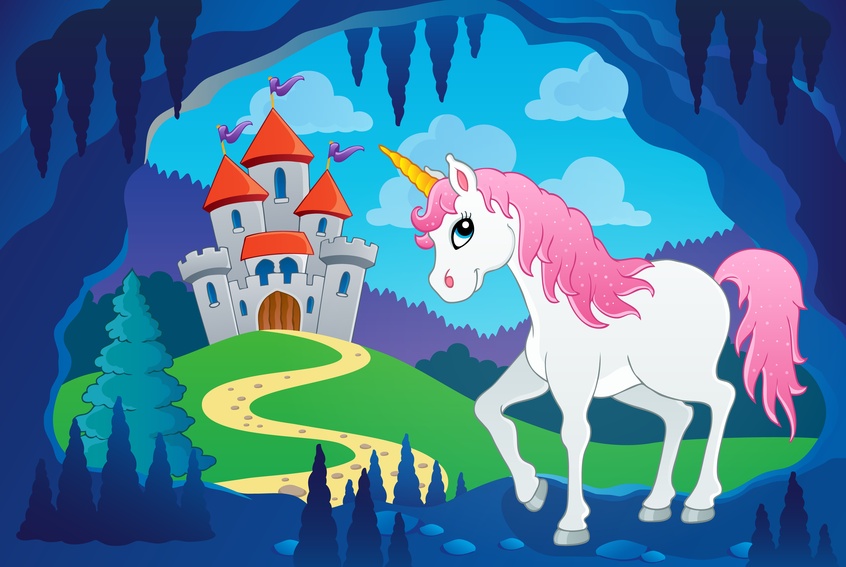

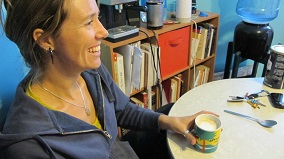
 Arianne Zwartjes brings the body into her writing. In Detailing Trauma, she looks at our anatomy and the intricate interactions between our organs, blood, muscles, tissues—all of it, really—in order to discover something about trauma and healing. Here, Zwartjes speaks further about hybridity and stretching the boundaries of genre, as well as a multitude of ways in which writing enriches our world and our experience of it.
Arianne Zwartjes brings the body into her writing. In Detailing Trauma, she looks at our anatomy and the intricate interactions between our organs, blood, muscles, tissues—all of it, really—in order to discover something about trauma and healing. Here, Zwartjes speaks further about hybridity and stretching the boundaries of genre, as well as a multitude of ways in which writing enriches our world and our experience of it.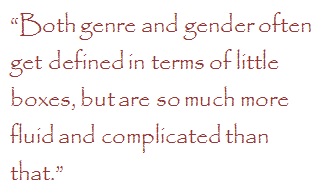 But when I sit down to write, I’m not thinking about “rebelling” or how what I write is going to break some boundary or evoke questions about its form. I’m writing what I like to read (or at least, I’m trying to do so): work that is multi-layered, thinky, linguistically beautiful, critical and questioning. I like work that brings together lots of different ideas, and looks at the sparks they create when they collide, and so that’s the way my writing process often occurs, also—putting very disparate things side by side, and seeing if they create chemistry. I like, also, to play with the tension between a given language set, often something technical like medicine, and my subject matter, which is often much more personal.
But when I sit down to write, I’m not thinking about “rebelling” or how what I write is going to break some boundary or evoke questions about its form. I’m writing what I like to read (or at least, I’m trying to do so): work that is multi-layered, thinky, linguistically beautiful, critical and questioning. I like work that brings together lots of different ideas, and looks at the sparks they create when they collide, and so that’s the way my writing process often occurs, also—putting very disparate things side by side, and seeing if they create chemistry. I like, also, to play with the tension between a given language set, often something technical like medicine, and my subject matter, which is often much more personal.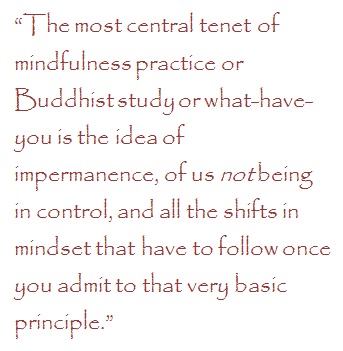 AZ: You know I think there’s a real dualism present in US society, because on the one hand we have this incredible, arrogant rhetoric about being “world leaders” and having all this influence and control around the world—and financially and militarily, unfortunately, we do—and all this capitalist advertisement-based rhetoric about becoming perfect: perfectly happy, perfectly beautiful, perfectly safe. But at the same time we’re very aware, on a gut level, that we are very much not in control, that our bodies get older and break down, that we can’t even predict, let alone control, what will happen to us in the next 24 hours. In fact, I think most of the rhetoric of the former probably has to do with our denial of the latter—or at least, to do with both that and with power. I’ve had a very serious meditation practice for a long time now, and really the most central tenet of mindfulness practice or Buddhist study or what-have-you is the idea of impermanence, of us not being in control, and all the shifts in mindset that have to follow once you admit to that very basic principle.
AZ: You know I think there’s a real dualism present in US society, because on the one hand we have this incredible, arrogant rhetoric about being “world leaders” and having all this influence and control around the world—and financially and militarily, unfortunately, we do—and all this capitalist advertisement-based rhetoric about becoming perfect: perfectly happy, perfectly beautiful, perfectly safe. But at the same time we’re very aware, on a gut level, that we are very much not in control, that our bodies get older and break down, that we can’t even predict, let alone control, what will happen to us in the next 24 hours. In fact, I think most of the rhetoric of the former probably has to do with our denial of the latter—or at least, to do with both that and with power. I’ve had a very serious meditation practice for a long time now, and really the most central tenet of mindfulness practice or Buddhist study or what-have-you is the idea of impermanence, of us not being in control, and all the shifts in mindset that have to follow once you admit to that very basic principle. AZ: I think the question of role is very personal, different for every individual. Obviously it’s critically important to find the voices of others out there in the world who have experienced, and found their way through the tangled labyrinth of healing from, a similar trauma to yours, whatever it may be. So the role of writers working through, publically and honestly and vulnerably and transformatively, their own struggles is critically important in the sense of offering succor, a sort of light forward. On the flip side, though, the question of how one navigates one’s way through via writing is very individual. For myself, I think writing is how I ask the questions that matter to me, and then try to write my way into some sort of deeper understanding, if not (and usually not) an answer.
AZ: I think the question of role is very personal, different for every individual. Obviously it’s critically important to find the voices of others out there in the world who have experienced, and found their way through the tangled labyrinth of healing from, a similar trauma to yours, whatever it may be. So the role of writers working through, publically and honestly and vulnerably and transformatively, their own struggles is critically important in the sense of offering succor, a sort of light forward. On the flip side, though, the question of how one navigates one’s way through via writing is very individual. For myself, I think writing is how I ask the questions that matter to me, and then try to write my way into some sort of deeper understanding, if not (and usually not) an answer.